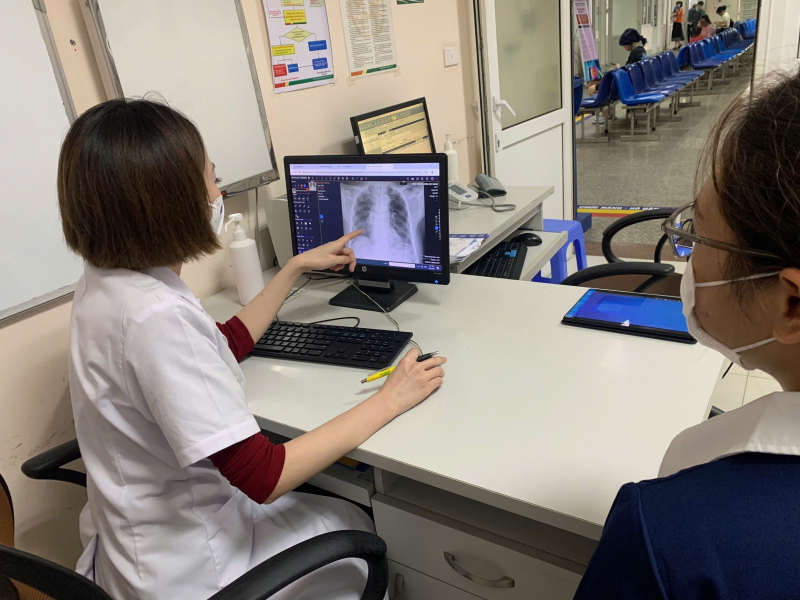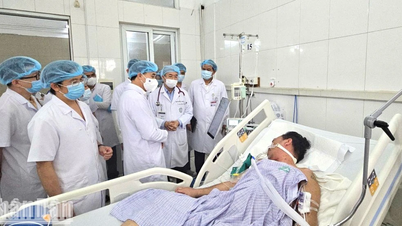According to the Ministry of Health, by April 2025, only 165/1,300 medical examination and treatment facilities nationwide will have implemented electronic medical records. Will the more than 1,200 medical facilities nationwide be able to complete this important task in more than 4 months? Meanwhile, the country currently has only 30 million Electronic Health Book accounts applied on VNeID, not meeting the demand of 50% of the population for health management nationwide.

The determination of the leader plays a decisive role.
As we mentioned in the previous two articles, the benefits of electronic medical records are still being implemented in many hospitals nationwide. According to Dr. Nguyen Ngo Quang, Director of the Department of Science, Technology and Training, Ministry of Health, implementing digital transformation in healthcare and Project 06/CP of the Government, the health sector has achieved very encouraging results so far. The level of digital transformation of the Ministry of Health ranks 11th out of 17 ministries and sectors responsible for handling administrative procedures, up 2 places compared to 2022.
99.5% of medical examination and treatment facilities have deployed hospital management software, connecting with 63 health insurance agencies of 63 provinces and cities. Currently, there are 2 localities nationwide that have completed 100% of public hospitals deploying electronic medical records: Phu Tho and Bac Ninh; many localities have detailed plans to deploy electronic medical records by September 30, 2025 according to the Prime Minister's Directive, such as: Thai Nguyen, Hanoi, Thanh Hoa, Quang Ninh, Nghe An...
Up to now, there are 165 medical examination and treatment facilities using electronic medical records instead of using paper medical records, of which, the most are in Quang Ninh with 22 facilities; Hanoi with 21 facilities; Phu Tho with 19 facilities; Ho Chi Minh City and Nghe An with 13 facilities each. However, there are up to 33 localities where no medical facilities have implemented it.
Some central hospitals have deployed electronic medical records such as: Bach Mai, Thong Nhat, Central Jaw and Face Hospital, Central Lung Hospital, Central Dermatology Hospital, Central Rehabilitation Nursing Hospital, Ho Chi Minh City University of Medicine and Pharmacy, Hanoi Medical University. In addition, some typical hospitals in deploying electronic medical records include: Phu Tho Provincial General Hospital, Vinh City General Hospital (Nghe An), Xanh Pon General Hospital, Cuoc Song General Hospital (Son La), Ho Chi Minh City Children's Hospital, etc.
What difficulties have led to many hospitals not being able to deploy electronic medical records? According to Dr. Nguyen Ngo Quang, currently, with the attention and strong direction of the Government, the Prime Minister, and the Ministry of Health, many provinces have determined to implement, prioritize resources, and focus on directing the deployment of electronic medical records to complete as required by the Prime Minister. The results of applying medical information technology (IT) in units and localities have had a strong change, up to now, the coverage rate of hospital information systems is 100%. However, the level of IT application is still low, uneven among hospitals, and data interconnection is still difficult. To have electronic medical records without using paper medical records, the information technology system at the hospital must be quite complete. “There are only 23 hospitals nationwide that have successfully deployed the RIS-PACS system without using film. Therefore, to deploy electronic medical records, these systems must be built and completed at the hospital. The larger the hospital, the more difficult and complicated the problem,” emphasized Dr. Nguyen Ngo Quang.
Sharing more about this, Associate Professor, Dr. Pham Quy Tuong, Chairman of the Vietnam Medical Informatics Association, said that the application of electronic medical records in Vietnam is facing many major barriers, from digital infrastructure, awareness of hospital leaders, to financial mechanisms and IT skills of medical staff. Hospital leaders play a decisive role in implementing electronic medical records. They not only need to clearly understand the benefits of this system, but also proactively invest in finance, human resources and organize specific implementation plans.
Many hospital leaders, when sharing about electronic medical records, all said that the financial problem is a "headache", because investing in IT requires a huge amount of money. Due to the large investment costs, many hospitals are still slow or have made plans but do not have funds, and have not implemented them synchronously but in parts. According to Dr. Nguyen Ngo Quang, the main difficulties and obstacles when implementing electronic medical records are due to the complexity of the professional examination and treatment process, the digital transformation process at each unit; the legal corridor for investment, hiring IT applications, and digital transformation is not complete; the financial mechanism and benefits when implementing are not complete, such as the cost of PACS application without printing films, there is no price structure for IT application costs in the price of medical examination and treatment services; IT human resources are still lacking and weak, etc.
Many experts are concerned that with the above difficulties, the goal of 100% of hospitals nationwide to deploy electronic medical records by September 30, 2025, will many medical facilities be able to do it?
Incorporate technology investment costs into medical examination and treatment costs
According to the Ministry of Health's report, the whole country has only more than 30 million Electronic Health Book accounts on the VNeID application, which does not meet the needs of 50% of the population with health management nationwide. Many medical examination and treatment facilities (especially private facilities) have not fully connected to send health insurance examination and treatment data to serve the connection and sharing of Electronic Health Book data. Human resources in health IT are still lacking and weak, failing to attract highly qualified experts and staff in the health sector.

Up to now, the Ministry of Health, in coordination with the Ministry of Public Security and relevant localities and units, is expanding support for other localities to deploy the establishment and management of electronic health records, including Ho Chi Minh City, Binh Duong, Quang Ngai, etc. In order for each citizen to have an electronic health book on the VNeID application, to connect and communicate with the personal health record system of the Ministry of Health, creating convenience for medical staff in diagnosing and treating diseases, and for people to monitor their own health status, it still requires the participation of the Ministry of Health, hospitals and local Departments of Health.
Dr. Nguyen Ngo Quang said that currently, there are about 3,000 laboratories nationwide, but only more than 10% of them are standardized. To connect test results between hospitals, the Ministry of Health will speed up the standardization of laboratories in the coming time. The implementation of electronic medical records helps the results to be easily connected and shared. Data from the district level, if meeting the standards, will also be accepted by the upper level. Thanks to that, patients do not need to spend millions, even tens of millions of VND more for re-scans when going to the upper level. Because of this great benefit, the Ministry of Health is continuing to direct units to promote the implementation of electronic medical records, striving to have 100% of hospitals nationwide complete electronic medical records by September 30, 2025.
Talking about the expectation of data interconnection, Associate Professor, Dr. Dao Xuan Co, Director of Bach Mai Hospital raised the issue: If we can digitize all electronic medical records, and medical facilities can link data with each other, we can share data in diagnosis and treatment, in referral and direction, bringing great benefits.
A patient from a distant province was scanned, but in that province, the doctor had no experience in diagnosis. In this case, if the data was linked with Bach Mai Hospital, Bach Mai Hospital would consult and read that data to find out the disease, instruct the doctor at the facility on whether to perform surgery, radiation therapy, or chemotherapy, without the patient having to transfer to Bach Mai Hospital. The doctor at the facility also learned more. "I just consulted a case in Phu Tho, just with the patient's code, we read the results and discovered that the patient had a very severe spinal injury, herniated disc stenosis, the patient could not walk, had weak and atrophied muscles. From that diagnosis, we recommended that this case must have surgery," said Associate Professor, Dr. Dao Xuan Co.
To achieve strong digital transformation, with the focus on implementing electronic medical records and effectively and substantially connecting data, according to Associate Professor, Dr. Tran Quy Tuong, first of all, the Ministry of Health needs to play a leading role in promoting digital transformation in healthcare. The synchronous development of technology platforms, specialized data systems and IT infrastructure will create favorable conditions for electronic medical records to come into practice. Along with that, the completion of the legal framework such as building mechanisms, policies, and professional guidance documents on digital transformation in healthcare needs to be built tightly, creating a clear legal corridor so that hospitals can effectively deploy electronic medical records.
For example, purchasing IT equipment is also a barrier when some hospitals are afraid to bid, but ask for funding... Therefore, it is necessary to quickly include IT costs in the price of medical examination and treatment services according to the provisions of the Law on Medical Examination and Treatment, so that hospitals have a legal basis and enough financial resources to invest in digital transformation without affecting other activities.
Along with that, according to leading experts, there needs to be a support mechanism, creating conditions for hospitals to invest and purchase. The Ministry of Health also needs to have strong enough sanctions for units and localities that are slow to deploy electronic medical records. On the other hand, the Ministry should also have a mechanism to reward hospitals that perform well, creating a model to spread the "double benefits" when applying electronic medical records. The head of the hospital plays a decisive role, if the hospital director gets involved with a determined spirit, it will be effective.
In addition, the coordination between the Ministry of Health, professional associations, technology enterprises and local authorities is a key factor for the digital transformation of hospitals to be implemented synchronously nationwide. Improving IT capacity for doctors and medical staff is also very important and practical, because they are the practitioners, so it should be focused on and done immediately.
Source: https://cand.com.vn/y-te/bai-cuoi-quyet-tam-lon-giai-phap-dong-bo-de-ve-dich-dung-hen-i768022/



![[Photo] Prime Minister Pham Minh Chinh receives Swedish Minister of International Development Cooperation and Foreign Trade](https://vphoto.vietnam.vn/thumb/1200x675/vietnam/resource/IMAGE/2025/5/12/ae50d0bb57584fd1bbe1cd77d9ad6d97)
![[Photo] Prime Minister Pham Minh Chinh works with the Standing Committee of Thai Binh Provincial Party Committee](https://vphoto.vietnam.vn/thumb/1200x675/vietnam/resource/IMAGE/2025/5/12/f514ab990c544e05a446f77bba59c7d1)

![[Photo] Prime Minister Pham Minh Chinh starts construction of vital highway through Thai Binh and Nam Dinh](https://vphoto.vietnam.vn/thumb/1200x675/vietnam/resource/IMAGE/2025/5/12/52d98584ccea4c8dbf7c7f7484433af5)





















































































Comment (0)